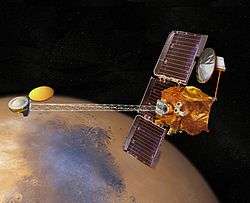Sky-Sailor
The Sky-Sailor is a concept for a robotic aircraft with embedded solar cells on its wings, developed by the Swiss Federal Institute of Technology in Zurich. It is hoped it will be able to search the Martian surface and even send pictures back to Earth. The reason the Sky-Sailor would have an advantage over other Martian rovers is because it can scan the Martian surface without touching it at any point, which removes many hazards and high energy costs.[1]
Sky-Sailor would be and autonomous, solar-powered Mars aircraft that would fly for one Martian day of 24 hour.[2] If this project is funded and developed, it should be able to take detailed pictures of Mars, especially in places where wheeled rovers cannot go.[3]
Concept and design
The challenge for the developers was to make a very light weight model, which was accomplished. After that, an autopilot had to be installed so a non-stop autonomous flight for 24 hours could be achieved. All this was tested with a scale model in a wind tunnel.[4]
Two major challenges for small autonomous aircraft for Mars are to keep the weight down, such as batteries and electronics and the other is designing the autonomous control systems for directing the flight.[5] Some design considerations is the amount of solar power available over the course of a Martian day, and another is the battery storage capacity, and the efficiency and weight of the solar cells.[6] One reason for a small size, was to facilitate its transport to planet Mars from Earth.[7]
The Sky-Sailor has a wingspan of about 3.2 meters and it weighs approximately 2.5 kilograms. Looking at aerodynamic studies, the power needed for the aircraft to fly at a low altitude is about 13.2 watts.[4]
Test flights
In 2007 a solar powered prototype made two flights totaling 10 hours. With a new battery, in 2008 it flew for 27 hours.[8]
Mission to Mars
If developed, the aircraft would be carried to Mars in a small aeroshell and that would be attached to a carrier spacecraft. Once the spacecraft has reached Mars, the aeroshell would be directly released into the Martian atmosphere.[4]
In 12 hours it could cover about 1,700 km (1,050 miles) over Mars, with the flight culminating in a crash landing.[9]
See also
References
- ↑ Greggs, Jessica. "Solar-powered plane will gaze down on Mars.(TECHNOLOGY)(Technical report)(Brief article)." New Scientist (January 2009): n. pag. Gale Virtual Reference Library. Web. 12 October 2009.
- ↑
- ↑ "Mission to Mars." Swiss News 3 Mar. 2004: 1+. Gale Virtual Reference Library. Web. 14 Oct. 2009.
- 1 2 3 Noth, A, et al. "SKY-SAILORDESIGN OF AN AUTONOMOUS SOLAR POWERED MARTIAN AIRPLANE." Sky-Sailor. Autonomous Systems Lab, n.d. Web. 14 Oct. 2009.<http://asl.epfl.ch/aslInternalWeb/%5Bpermanent+dead+link%5D ASL/publications/uploadedFiles/Sky-Sailor-Paper-Final.pdf+sky-sailor&cd=2&hl=en&ct=clnk&gl=us>.
- ↑
- ↑ Noth, A; Bouabdallah, Samir; Michaud, S; Siegwart, Roland; Engel, Walter (2004-01-01). "SKY-SAILOR Design of an autonomous solar powered martian airplane".
- ↑ Noth, ré; Leutenegger, Stefan; Rol; Siegwart; Engel, Walter. "Designing solar airplanes for continuous flight | SPIE Homepage: SPIE". Retrieved 2018-07-19.
- ↑ http://www.sky-sailor.ethz.ch/
- ↑ "The 10 Best Solar Airplane Concepts". AENews. Retrieved 2018-07-19.

.jpg)
.jpg)